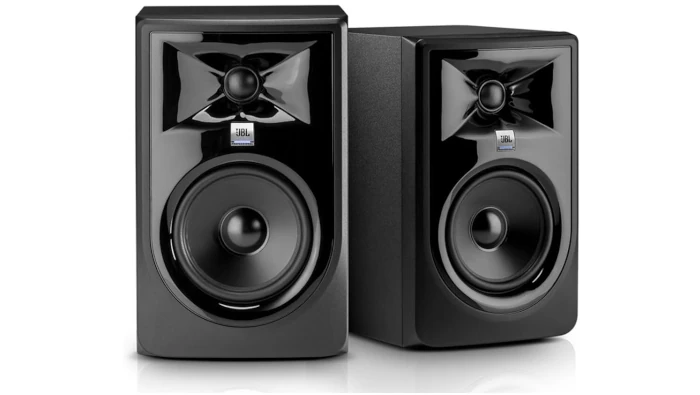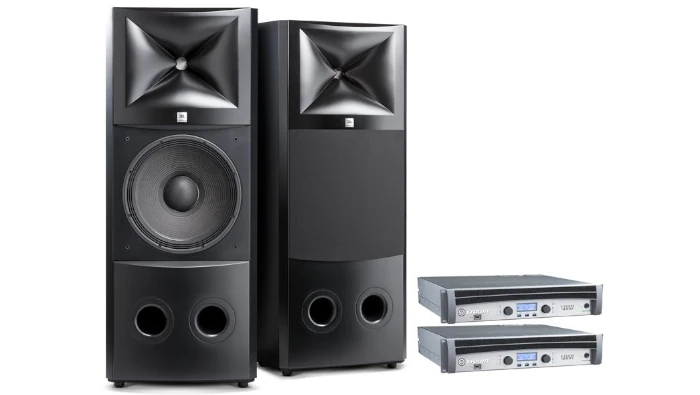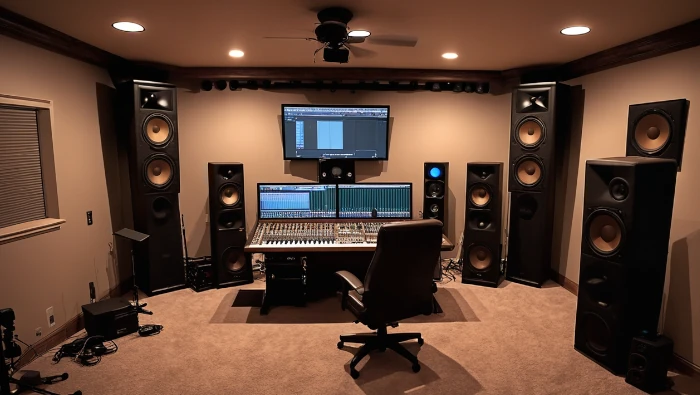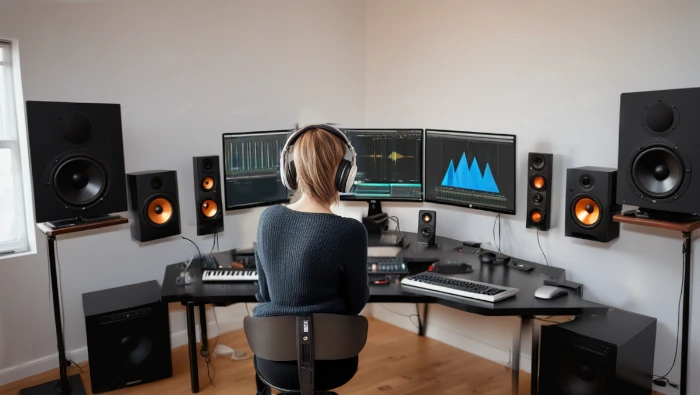Choosing the right studio monitor is crucial for anyone serious about music production. Studio monitors are designed to provide accurate and uncolored sound reproduction, which is essential for mixing and mastering tracks. They allow producers to hear their music exactly as it is, ensuring that any adjustments made during production translate well across different playback systems.
There are two primary types of studio monitors: nearfield and farfield. Each type has distinct characteristics that make them suitable for different studio environments and applications. Understanding these differences is key to selecting the right monitor for your needs.
Nearfield monitors are typically used in smaller studios and are placed close to the listener. They are designed to minimize the impact of room acoustics, providing a more direct sound. On the other hand, farfield monitors are larger and intended for use in bigger studios. They are placed further away from the listener and interact more with the room’s acoustics, offering a broader and more immersive soundstage.
Why Studio Monitors Matter
Studio monitors are an integral part of the recording and production process. Unlike regular speakers, which are often designed to enhance certain frequencies to make music sound more pleasing, studio monitors aim to provide a flat frequency response. This means they do not artificially boost or cut any part of the sound spectrum, allowing producers to make precise adjustments based on an accurate representation of their recordings.
Accurate sound reproduction is vital for several reasons. Firstly, it ensures that mixes translate well across various playback systems, from car stereos to high-end home audio setups. Secondly, it helps identify and correct issues in the mix, such as imbalances in frequency ranges or unwanted noise. Thirdly, it aids in achieving a professional sound quality that meets industry standards.
For more tips on setting up your home studio, check out this article on recording audio from Google Chrome.
Understanding the specific uses and advantages of nearfield and farfield monitors can help you make an informed decision. By choosing the right monitors and setting them up correctly, you can ensure that your music production process is both efficient and effective, leading to professional-quality results.
What Are Nearfield Monitors?

✅ Check Price on Amazon
As an Amazon Associate I earn from qualifying purchases.
Nearfield monitors are designed for close-range listening, typically placed within a few feet of the listener. These monitors are engineered to deliver a precise and accurate sound that minimizes the influence of the surrounding room acoustics. This makes them ideal for smaller studio spaces where reflections from walls and ceilings can significantly color the sound.
Advantages of Nearfield Monitors
One of the primary advantages of nearfield monitors is their ability to provide a detailed and focused sound image. By reducing the effects of the room, these monitors allow producers to hear more of the direct sound from the speakers. This clarity is crucial for tasks such as mixing and mastering, where fine details can make a significant difference in the final product.
Nearfield monitors are generally compact, making them easy to position on a desk or dedicated stands. Their smaller size does not compromise their performance; many models offer excellent frequency response and power output suitable for professional use. When setting up nearfield monitors, it’s important to form an equilateral triangle with your listening position to ensure the best stereo image and accuracy.
Benefits in Small Studios
These monitors are particularly beneficial in home studios or smaller professional studios where space is limited. They are designed to be used at lower volumes compared to farfield monitors, which helps in avoiding excessive room noise and reflections. This feature is especially useful in untreated rooms or spaces that lack comprehensive acoustic treatment.
For those looking to set up a home studio, it’s important to avoid common setup mistakes. Understanding proper positioning and acoustic treatment can make a big difference in your studio’s sound quality. If you’re interested in learning more, consider reading about 5 tips to improve your home studio audio quality.
In summary, nearfield monitors are an excellent choice for environments where space and acoustics are a concern. Their design focuses on delivering clear and precise sound, which is essential for accurate mixing and mastering. Properly setting them up and understanding their benefits will greatly enhance your audio production capabilities.
Key Differences Between Nearfield and Farfield Monitors

✅ Check Price on Amazon
As an Amazon Associate I earn from qualifying purchases.
The differences between nearfield and farfield monitors go beyond just their size and placement. These distinctions affect how each type performs in different studio environments and applications.
Size and Design: Nearfield monitors are smaller and more compact, designed to be placed close to the listener. They typically have smaller drivers and enclosures, making them easy to position on a desk or stands. Farfield monitors, in contrast, are larger with bigger drivers and enclosures, designed to fill a larger space with sound and provide a more immersive listening experience.
Sound Dispersion: Nearfield monitors provide a more focused sound with less interaction from the room, making them ideal for detailed work such as mixing and mastering. This focused sound ensures that reflections from walls and ceilings have minimal impact on the audio quality, allowing for more precise sound reproduction. Farfield monitors, on the other hand, offer a wider sound dispersion. They interact more with the room’s acoustics, which can be beneficial in larger, well-treated spaces where the room’s characteristics enhance the listening experience.
Frequency Response: While both types can deliver high-quality sound, farfield monitors generally have an advantage in reproducing lower frequencies due to their larger drivers. This can be beneficial for genres that require a strong bass presence. Nearfield monitors also provide excellent frequency response but are often better suited for mid and high frequencies, making them ideal for critical listening and detailed audio work.
Listening Environment:
Nearfield monitors excel in small, acoustically untreated spaces. They are designed to be used at close range, minimizing the effects of room acoustics. Farfield monitors perform best in larger, well-treated rooms where their interaction with the environment can be controlled and utilized to enhance the listening experience. Proper acoustic treatment in such spaces is essential to avoid unwanted reflections and standing waves that can distort the sound.
For more insights into setting up your monitors effectively, consider reading about how to improve audio recording quality in your home studio. This guide provides valuable tips on optimizing your studio environment for the best sound quality.
Pros and Cons: Both nearfield and farfield monitors have their advantages and disadvantages. Nearfield monitors are more affordable, easier to position, and provide accurate sound in small spaces. However, they might lack the power and low-frequency extension of farfield monitors. Farfield monitors offer a broader soundstage and better low-frequency response but require more space and careful acoustic treatment to perform optimally.
Understanding these key differences will help you choose the right monitor type for your studio environment and production needs. Whether you opt for nearfield or farfield monitors, ensuring proper setup and acoustic treatment will greatly enhance your audio production capabilities.
Choosing the Right Monitors for Your Studio

When choosing between nearfield and farfield monitors, several factors need to be considered to ensure the best fit for your studio. Room size, budget, and specific listening needs all play a crucial role in this decision.
Room Size: For small studios, nearfield monitors are usually the best choice. Their compact size and close-range design make them ideal for limited spaces. They minimize the impact of room acoustics, allowing for precise and accurate sound reproduction even in untreated rooms. On the other hand, farfield monitors are better suited for larger studios where there is enough space to position the monitors several meters away from the listening position. This setup takes full advantage of the farfield monitors’ ability to interact with the room acoustics, providing a more immersive listening experience.
Budget: Nearfield monitors tend to be more affordable than farfield monitors, making them accessible for home studios and beginners. There are many high-quality nearfield monitors available at various price points, offering excellent performance without breaking the bank. However, if your budget allows, investing in high-quality farfield monitors can significantly enhance your studio’s capabilities, especially if you have a larger space and proper acoustic treatment.
Listening Needs: Consider what you will primarily use the monitors for. If detailed mixing and mastering are your main focus, nearfield monitors are likely the better choice. Their ability to provide a clear and precise sound image makes them ideal for critical listening tasks. If you need monitors for tracking and client playback in a larger room, farfield monitors might be more suitable. Their powerful output and expansive soundstage are beneficial for full-room playback and final mix checks.
Practical Considerations:

When setting up your monitors, proper placement and acoustic treatment are crucial for achieving the best sound quality. Nearfield monitors should be positioned at ear level and form an equilateral triangle with your listening position to ensure accurate sound imaging. For farfield monitors, ensure the room has sufficient acoustic treatment to manage reflections and standing waves that can distort the sound.
For those on a tight budget, there are excellent nearfield monitors that offer great performance. However, if you’re looking to invest more in your studio setup, understanding the best time to record in your studio can also help you optimize your production process and make the most of your equipment.
Recommendations: For small home studios, popular nearfield monitors include the KRK Rokit series and Yamaha HS series, known for their reliability and accurate sound reproduction. For larger studios, farfield monitors such as the Genelec 1038B and JBL M2 Master Reference Monitors are excellent choices, offering powerful output and exceptional sound quality.
In conclusion, choosing the right monitors involves considering your studio size, budget, and specific listening needs. Both nearfield and farfield monitors have their advantages, and understanding these will help you make an informed decision that enhances your studio’s audio production capabilities.
Conclusion: Making an Informed Decision
Choosing the right studio monitors is a crucial decision that can significantly impact your production quality. Nearfield and farfield monitors each offer unique benefits, and understanding these differences will help you make an informed choice.
Nearfield monitors are ideal for smaller studios and detailed work, providing a focused and accurate sound. Their design minimizes room reflections, making them suitable for environments where space and acoustic treatment are limited. This makes them perfect for mixing and mastering, as they allow you to hear a clear and precise representation of your music.
Farfield monitors, on the other hand, are well-suited for larger studios where the room size allows for greater distance between the monitors and the listener. They interact more with the room’s acoustics, offering a wider and more immersive soundstage. This makes them ideal for tracking sessions, playback for clients, and final mix checks. The ability to reproduce low frequencies more effectively also makes them beneficial for genres that require a strong bass presence.
When setting up your studio, it’s essential to consider the specific characteristics of your space. Proper placement and acoustic treatment are key to maximizing the performance of your monitors. Nearfield monitors should be positioned at ear level and form an equilateral triangle with your listening position. For farfield monitors, ensuring that the room has adequate acoustic treatment will help in achieving a balanced sound that accurately represents your mixes.
It’s also important to consider your budget. High-quality monitors are available at various price points, and investing in the best monitors you can afford will pay off in the long run. For those just starting out or looking to upgrade their current setup, researching and testing different monitors in your studio environment can provide valuable insights into how each type interacts with your room acoustics.

